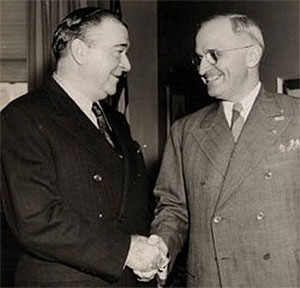The Truman Committee

Harry S Truman Library
Harry Truman was at it again. When the United States entered World War I a wave of patriotism overcame Harry Truman and he enlisted to serve in the armed forces. He did not have to as Truman had exemption. In fact, he was not expected to even bother enlisting. He was a thirty-three year old man helping his widowed mother run a 600 acre farm. His duty was to stay home and run the farm that would feed the troops serving overseas. But he enlisted and served anyway. Now 24 years later, the Japanese had attacked Pearl Harbor and a wave of patriotism once again overcame Senator Truman. Feeling the need to do something, he walked into the office of General George Marshall, Chief of Staff of the Army. Truman asked if he could re-enlist. The General politely refused the Senator’s offer and said his services would be needed in the nation’s capital. Indeed, the General was right for nine months earlier the Truman Committee was formed.
Officially known as Senate Special Committee to Investigate the National Defense Program, it soon became known simply as the Truman Committee, named after the committee’s founder and chairman. Realizing American industry was converting from the production of civilian to military goods and the potential of fraud and waste was possible (even down right likely), Senator Truman was proactive in forming a committee to investigate the defense industry. During the three years as chairman the Truman Committee investigated camp construction, shipbuilding, raw material availability and shortages, government contracts, the manufacture of airplanes, mobilization, and the administration of the war production program, just to name a few. Over the course of the committee’s existence, thirty two reports were issued, dozens of suggestions made, and according to one estimate, $15 billion saved. [i] The committee propelled Truman to the national spotlight and in 1944 would be nominated as Franklin Roosevelt’s vice president.
Of all the accomplishments made by the Truman Committee, one critical decision seems almost overlooked as the years passed. The United States Navy was struggling to find a new amphibious assault landing craft that could be used to land American soldiers on beaches when the time came to invade Europe and South Pacific Islands. The Navy Bureau of Ships refused to deal with a contractor who was hot-tempered, had a reputation of a heavy drinker, and used too much wood instead of metal in his boats. His name was Andrew Higgins of Higgins Industries.[ii]
Not to be deterred, Andrew Higgins traveled to Washington and met Senator Truman several times. Truman was won over with Higgins design of landing craft, the LCVP (landing craft, vehicle and personnel). Truman challenged the navy to test Higgins boat head-to-head with landing craft currently in production. In summing up the competition, Major Howard Quinn of the U.S. Army’s Quartermaster Corps wrote, “As far as comparisons of characteristics…are concerned, it may be stated that on May 25 tests there was no comparison. It was clearly demonstrated even to our enlisted men accompanying the tests that the Higgins lighter could get them there in a choppy sea and the other lighter just couldn’t make the trip.” After the Truman Committee’s report the Navy Bureau capitulated and Higgins was awarded the contract.[iii]
How did the Higgins LCVP perform at D-Day? About Andrew Higgins, General Eisenhower said, “He is the man who won the war for us. If Higgins had not designed and built those LCVPs, we never could have landed over an open beach. The whole strategy of the war would have been different.”[iv]
And perhaps the United States won the war because Harry Truman was willing to give a hot-tempered heavy drinking contractor a chance.
Last updated: December 2, 2015
